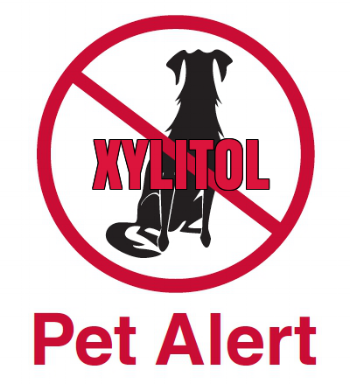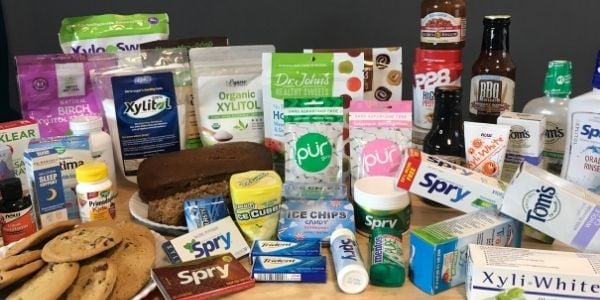
You are understandably panicking because your dog just consumed a product that contains xylitol.
Symptoms can be evident within 30 minutes of ingestion but may take up to 3 days.
If you suspect that your dog (or cat) has ingested any products containing xylitol, regardless if it may have been just now or 3 days ago, have your dog evaluated by a veterinarian immediately.
Xylitol is a potent and very fast-acting poison in dogs — Time is of the essence!
Here are the steps you need to take if you know or suspect that your dog ate something that had xylitol in it.
Evaluate Your Dog and Get Them the Help They Need — Fast!
Ask yourself: Is my dog staggering, walking like they're drunk? Is my dog collapsing, having seizures, or vomiting? Does my dog seem “out of it?” If so, or if there are any other concerning signs, follow these steps:
- Corn syrup, Karo syrup, maple syrup, or cake decorating gel: If you have one of these types of syrups or gels handy and you can do so without getting bit or without overly delaying Step 2 below, rub some onto your dog’s gums.
This is a TEMPORARY fix to try and raise their blood sugar and counteract the insulin released as a result of the xylitol.
DO NOT pour the syrup into your dog's mouth — you could make matters significantly worse by doing so! - Get to a veterinarian: Even if their concerning signs improve after you’ve rubbed syrup onto their gums, get them immediately to the vet. Again, the syrup is a temporary fix and their blood sugar is likely to plummet again.
Go immediately to your vet, or to your nearest open Animal ER if your vet isn’t open or can’t get you in.
Ideally, call them while you’re on your way to let them know that you’re coming in and what’s wrong with your dog. That way they can be ready to initiate immediate treatment and evaluation upon your arrival.
You may be thinking: “My dog ate xylitol and seems fine. Should I do anything?” or “Do I need to take my dog to vet since they ate xylitol 3 days ago?” If you know or suspect, that your dog’s eaten something that has xylitol in it, it’s still immensely important that you err on the side of caution and take this important step:
Call for advice: Time is always of the essence when it comes to animal poisonings, and that’s even more so the case when xylitol is involved! Call your veterinarian or one of the dedicated animal-specific poison control hotlines immediately for advice on what to do and what to watch for.
Have the product or packaging handy: When contacting poison control and/or going to the vet, have handy or bring the packaging of the product your dog ate (or whatever's left of it). It's important for the team that's giving you advice and treating your dog to know what's listed on the ingredient label.
Sometimes the concentration of xylitol in each serving is disclosed, which is important in evaluating the severity of the poisoning (how much xylitol versus the weight of your dog), although often the concentration of xylitol is not listed; that's why we're asking everybody to support the Paws Off Act of 2021 (HR 5261) to improve xylitol labeling standards.
Questions? If you're concerned your dog ate xylitol and would like to chat with a veterinarian, Click here
Quick Xylitol Toxicity Facts You Should Know
- Dogs rapidly and almost completely absorb xylitol following ingestion.
- Ingestion of greater than 0.1 g/kg can result in hypoglycemia (low blood sugar) and greater than 0.5 g/kg may result in acute liver failure.
- Xylitol can cause low blood sugar within 30 minutes after ingestion.
- Signs include weakness, shaking, dilated pupils, and if not treated seizures.
- Signs include weakness, shaking, dilated pupils, and if not treated seizures.
- Symptoms of hypoglycemia can take up to 12 hours to appear following ingestion.
- Initial symptoms of xylitol toxicity include vomiting, trembling, weakness, collapse, and seizures. Death is possible.
- Within 12 to 24 hours, liver damage begins to happen.
- Major liver necrosis (death) can be caused by high doses of xylitol. This medical condition can lead to death.
- It may take 2 to 3 days following ingestion for symptoms of liver injury to be noted.
- Signs include change in appetite, lethargy, jaundice (yellow skin), vomiting, and diarrhea.
- Signs include change in appetite, lethargy, jaundice (yellow skin), vomiting, and diarrhea.
- Lab work can be used to detect elevated liver enzymes as early as a few hours following ingestion but it is possible for them to be delayed up to 24 to 48 hours.
- Major liver necrosis (death) can be caused by high doses of xylitol. This medical condition can lead to death.
- Some dogs develop prolonged clotting times, decreased platelets, as well as bruising and gastrointestinal hemorrhages.
- In some dogs, hypoglycemia may not be evident but the liver can still become injured.

Other Names for Xylitol in Product Ingredient Lists
- Alcohol Sugar (this could include other sugar alcohols and not include xylitol)
- Birch Sugar
- Birch Bark Extract
- CHO
- E967
- Kabocha Extract (made from Kabocha pumpkins)
- Meso-Xylitol
- Méso-Xylitol
- Pentahydric alcohol
- Penta-hydroxy
- Pentane
- Sucre de Bouleau
- Wood Extract
- Xilitol
- Xylit
- Xylite
- Xylo-pentane-1,2,3,4,5-pentol
Sometimes xylitol is listed in “inactive ingredients” or in the “other ingredients” list. These lists are not required to be itemized in order of quantity of the ingredient in the product, as it is in the main ingredient label. This unfortunately can cause people to incorrectly assume that there is a small amount of it in the product.
What is Xylitol?
It is a natural sugar alcohol found in plants. It is used as a sugar substitute due to its sweet taste. To make medicine, it is extracted from birch wood.
Xylitol is being used in an increasingly wide range of products (see our list of over 700 products xylitol is in) such as medications, dietary supplements, sweets and candies, foods, toothpaste, mouthwash, chewing gum, and even clothing. Therefore, more and more dogs are getting sick from eating this “all-natural” sugar substitute.
Xylitol is poisonous to dogs — in 2018 alone, the Pet Poison Helpline received almost 4,000 cases. Now, their database has more than 20,000 cases, ranging from 2013 to 2018.
At the Pet Poison Helpline, there was an increase of 108% between 2015 and 2020 in calls regarding xylitol poisoning. From 2018 to 2019 the biggest increase was noted with calls increasing by 47.2 %.
Xylitol poisoning calls to the Helpline in 2020 were second only to chocolate poisoning calls. Of the over 370,500 calls to ASPCA-Animal Poison Control in 2020, food items (including xylitol) ranked number 3 in the top ten toxins. It made up 13% of the calls (about 48,165). In 2021, it remained in the number three spot of the over 401,000 calls they received.
These staggering numbers are just the cases that are reported to the animal poison control hotlines. There are many more that never get reported, either because the attending veterinary team gets it well under control without the input from the specialists at poison control, or because the dog never even makes it to the veterinary hospital.
Is Xylitol Toxicity Treatable?
Fortunately, with prompt recognition, quick diagnosis, and appropriate treatment, the prognosis for a dog that eats a product containing xylitol can be good. Of course, there are many factors that will impact your dog’s odds of recovery and survival, including the amount of the product they ate, how much xylitol it contained, how recently they ate it, your quickness in taking action, and a host of others.
Pets are typically hospitalized for emergency care, treatment, and observation. In order to closely monitor changes in blood glucose (sugar), organ function, and electrolyte balances, it will be necessary to routinely repeat blood tests during the extended stay.
The treatment for xylitol poisoning typically includes addressing the hypoglycemia, the imbalance of electrolytes, and possible liver failure. These treatments may include:
- Intravenous fluids for balancing electrolytes and preventing dehydration
- Intravenous dextrose to address the hypoglycemia
- Medications to protect the liver
- Medications to control nausea and vomiting
- Hourly monitoring of blood glucose levels
- Continuous monitoring of heart and respiratory rate as well as blood pressure
- Medication for seizure control, if needed.
When treated immediately, most dogs usually recover from xylitol poisoning. Sadly, this wasn't the case for Lucy, the 5-year-old Lab, who ate zucchini bread made with xylitol.
Report Your Case to the Food & Drug Administration
It is important to take the time to report the incident to the FDA. They WANT to hear from you!
The FDA’s Division of Veterinary Product Safety shared the following list with us in response to our communications with them and asked us to share it with our readers and petition signees. They truly wish to — and need to — know about what happened.
They shared with us that “Submitting an adverse event report by the appropriate method enhances the ability of FDA to efficiently handle and evaluate reports. We encourage the submission of these reports to aid in monitoring their safety and in keeping the public informed about safety concerns.”
The FDA needs to know the details and how widespread the problem is so that they can know how to best respond. The appropriate method to report your case depends on the type of xylitol-containing product your dog got into. See the two methods below.
How to Report Cases of Xylitol Poisoning to the U.S. FDA
- Reporting poisoning cases and other adverse events in animals resulting from foods and other edibles is done either through the online Safety Reporting Portal or by calling your FDA District Office.
"Foods and other edibles” includes such xylitol-containing products as candies, gums, mints, chocolates, peanut and nut butters, raw xylitol, desserts, yogurt, jams, syrups, condiments, sauces, water and drink powders, power and protein bars, and powders, and any other foods. Additional information about reporting food product adverse events in pets can be found here.
- Reporting poisonings and other adverse events in animals associated with pharmaceuticals, supplements, cosmetics, and health care products that are not foods, or, for products specifically approved for use in animals, contact the drug manufacturer, is done by submitting Form FDA 1932a on this page.
This is the procedure for reporting cases where xylitol-containing toothpaste, floss, mouthwash or rinses, medications, vitamins, supplements and oils, cosmetics, hair care, body and face care, and other personal care products, and devices are involved.

Spread the Word — Awareness Saves Lives!
It's time to raise awareness, to have your voice heard, and to help others avoid a similar situation. Here are some of the ways you can do this:
- Share your story on your Facebook or Instagram page, or on TikTok — it’s a great way to let your friends, family, and any followers know about this danger and what you’ve been through.
- Share our social xylitol posts on your social pages and here’s a whole Xylitol & Dogs Pinterest Board we’ve created.
- Support the Paws Off Act of 2021 (HR 5261).
- Directly contact the manufacturer of the product your dog ingested. Let them know about what happened and ask them to make label changes.
- Contact your local TV news station and/or newspaper. Ask them to do an awareness and pet safety piece about your and your dog’s experience with xylitol. Share your story with us below, as we get contacted by media often for cases across North America.
- Download our free xylitol awareness poster. Print out copies and bring them to your veterinarian, groomer, local dog parks, pet stores, and any other local businesses that will hang them for you.
We hope that this article has been helpful for you and we’re sorry to hear that your dog has been affected by xylitol. Know that we, and others, are working hard to raise awareness and help prevent xylitol poisonings. We wish for the best outcome for you and your pooch, and sincerely thank you for sharing your story to help others avoid a similar situation.





